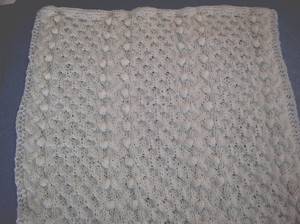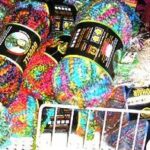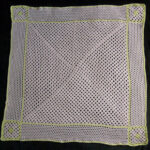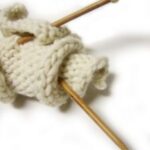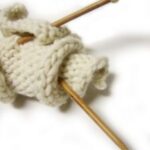I had a request from a friend for a simple Baby blanket pattern. One that was both “easy and tried and true.” The problem with that is that the one that I make most often is fairly complex with Cables, Bobbles and Honeycombs. As I started to reply to her, I realized that my answer was more complex than I first thought and might be interesting to lots of people. I have been knitting baby blankets for thirty years. They are wonderful gift for a new mother, but there are some things that need to be considered before you make the blanket. I have written this to give you a some advice before you simply run into a store and buy yarn and a pattern and find that you really aren’t happy with what you are producing or have produced.
Supplies: Yarn
1)Since it is for a baby, the yarn should be machine washable and dryable. Babies spit up and are messy. New Moms don’t have time to wash things by hand and lay them out to dry.
2) If I know the gender I can use pink or blue, but if I am making the blanket ahead of time any pastel is good, but my favorite color is white.
3) It is nice if the yarn has a “nice hand” – that means it is soft to the touch. Not only is it more pleasant for the baby’s skin, it is more pleasant to work with.
4) How much yarn you need depends on how big you want to make the blanket. Blankets can range in size from 30″ x 30″ for a Preemie, to 36″ x 42″ for a child give or take an inch or two to accommodate whatever pattern you want to use.
5) In general the yarn used should be no heavier than worsted weight. Finer yarn makes a lighter blanket, uses more stitches, smaller needles and takes longer to make.
6) The needle size will be suggested by the yarn you choose. Mostly you can just look on the yarn wrapper. Then try a swatch of your pattern and go up or down in needle size depending on how it looks. A larger needle will give you a more airy blanket, while a smaller needle will give you a more dense effect.
As with everything there is an exception to the rules. I have made several blankets, using four strands of yarn at one time, and very large needles (size 35). Needles to say, it worked up really fast. It came from “Big Needle Instant Easy Crocheting & Knitting” which was Book no 17580, published by C. J. Bates & Son, Inc. in Chester, CT 06412. I can find no publication date, but I have used it since the ’70s or earlier and the styles in it may be even earlier. The Pattern involves what is essentially knitting the second stitch and then the first for the whole row. For this pattern you would need one ball of yarn for the number of strands that you used. I remember doing it with three strands and my notes say I cast on 50 stitches rather than the 60 stitches called for.
Patterns: When I am making baby blankets, I try not to make the blanket too lacy so the baby’s fingers will not get caught in the blanket. You can use any pattern that will make a square or rectangle. There are dozens of dishcloth patterns available. Scarf patterns can be adapted, by adding repeats of a segment of the pattern to increase the width. To make the blanket look nice, you need to add the same repeat on both side of the center of the original pattern. You can make a pattern as complex or simple as you want. The easiest pattern I have used, involved blocks of stockinette stitch (knit a row, purl a row), alternated with blocks of garter stitch (knit each row). For example you might want to work x number of garter stitch and x number of stockinette stitch for y rows to make a square or rectangle. Then reverse and knit stockinette stitch where the garter stitch was and garter stitch where the stockinette stitch was. This makes a nice baby blanket. If you use a finer weight yarn it can be quite elegant. You can adapt the size by adjusting the number of stitches to whatever size you want it to be.
Edges are usually either Garter Stitch, or Seed Stitch to prevent them from curling in. For Garter Stitch, I usually begin by knitting 4 to 6 rows, depending on how I cast on. Then I always knit the first and last 4 stitches and knit 4 to 6 rows before I bind off. What I do between those stitches varies, by my mood. For Seed Stitch I work on an uneven number of stitches. I work a slip one, Knit one, Purl one to the end, for the first eight rows. I continue working 5 stitches up each side in this pattern and then repeat the first eight rows before I bind off. The hardest part of this is being certain that you have enough yarn to work the last rows and bind off. You can make the edges wider or narrower, by changing the number of rows at the beginning and end, and the number of stitches on each side.
The center of the blanket can be as imaginative or simple as you want. You could simply knit a particular number of rows in stockinette stitch and then do a row of garter stitch. I found a heart pattern in a Vogue Knitting Special Collectors Issue that was published in 1991. It made a beautiful baby blanket by increasing the number of repeats. The pattern that I make most often is from Art No. 4950 Yarn Kits Inc. and was published in 1979. It is called Honeycomb Cables. A friend gave that to me ten years ago. It has a note in her hand that says “better to skip popcorn.” It looks fine without the “popcorns” which are also called bobbles. It looks more hand made with the bobbles. You can find lots of patterns in any of the collections of stitches that are available. Calculate the number of stitches the pattern requires and work out how many repeats needed to get the blanket width you want.
I have only one baby blanket for a picture, since I have given them all away. The one I have is the pattern mentioned above and is waiting to be needed for someone’s new baby. I usually try to keep pictures of what I have knitted so I was surprised to find I had no baby blanket pictures. I cannot provide you with directions for a blanket, because I am unwilling to violate any copy-write laws. If you have no scarf or dishcloth patterns then I suggest you join Ravelry at www.Ravelry.com where you can find patterns for almost any knitting project that you want to make. A baby blanket is a gift that is welcomed by any mother, and can be a chance for you to play with patterns you might not get a chance to make otherwise.Your decisions will make the blanket truly an individual gift.
